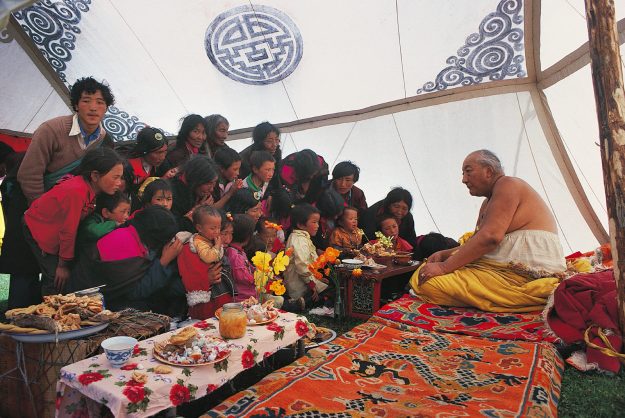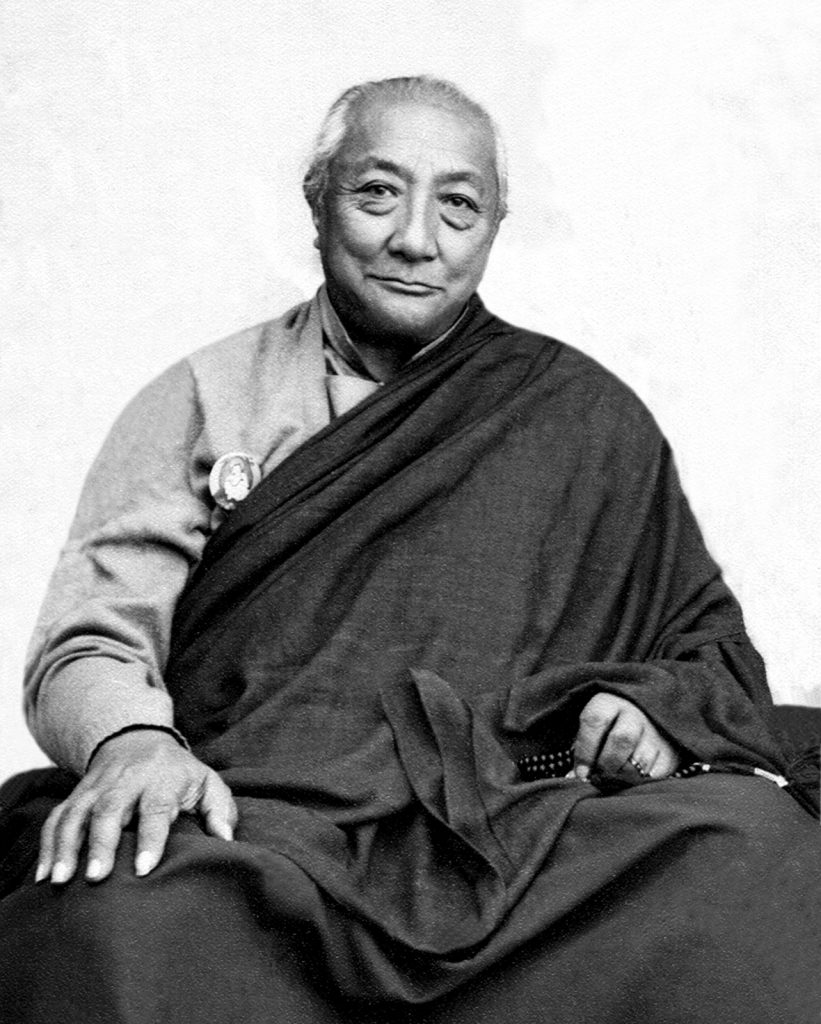In February 1975 I was a young man of eighteen on pilgrimage in India when I came to Kalimpong in the Darjeeling district. I had never heard of Kyabje Dilgo Khyentse Rinpoche, but somehow I was granted an audience with him at a small temple where he was staying on the evening before Tibetan New Year [Losar]. He received me very kindly and, through a translator, asked me about my travels. I saw him on the following day, New Year’s Day, and then met him again a week later at the cremation of another great Tibetan master, Kangyur Rinpoche (1897–1975). Kyabje Khyentse Rinpoche was no doubt the most extraordinary human I had ever met, or even imagined. He was physically towering and naturally majestic and graceful, giving meaning to one of his many names, Pema Garwang Ösel Dongale Linpa, “Luminous Lord of Lotus Dance.” As I understood that dharma is learned through apprenticeship with an authentic master, I spent the next sixteen years studying with him and the magical net of great beings connected with him.
In addition to being a sublime learned sage, Khyentse Rinpoche emanated warmth and down-to-earth humorous insight that dissolved all hierarchical or cultural barriers. When I was around him, I sensed a universal warmth that was palpable, and humorous insight permeated the joyful, awake ambiance he created. In his presence, my constructions of my person were only too nakedly evident. But with his empowering wisdom and love—sometimes gentle, sometimes fierce—these constructions became transparent and workable conditions, and I felt inspired by his vast perspective, which saw the greater picture of buddhanature. In his presence no one was a VIP and no one was unworthy; he created a vibrant sense of a sacred world in which insecurities and the need for credentials melted away.
As Dzongsar Jamyang Khyentse, Chögyam Trungpa, Matthieu Ricard, and others have chronicled, Khyentse Rinpoche was never in a hurry, and he would care tirelessly for anyone who came to see him. He would pass months and years on end visiting temples and scholastic institutions, constantly teaching and receiving individuals, without ever having any privacy. He invited anyone into his spacious kingdom of awakening, welcoming them as possessing the lineage of awakening, and seeking to make them recognize that.
I have not found in any of his close disciples— the innumerable tulkus, rinpoches, lamas, yogis, nuns, monks, and laypeople that sought training at his feet—any rivalry or territorialism. On the contrary, over the years I have identified a kind of irreverent respect shown among these heirs to Kyabje Khyentse Rinpoche, and sense in them this greatness of mind that penetrates the artificial constructions of self and other. These sublime individuals carry within them the rich sunlit space of freedom from delusion that is wisdom, khyen, inseparable from compassion, tse, the tireless caring for others.
Through his powerful buddha activity, and some remaining merit of this world, the images and teachings of Kyabje Dilgo Khyentse Rinpoche are still with us. Whether we met him in the flesh or not, the thought of Khyentse Rinpoche invokes greatness and the qualities of awakening, and as such he is present within us. The photographs and the books containing his teachings are not just documentation of a deceased great sage, but can be seen as keys to unlock the innate wealth that is our enlightened heritage or potential. With the following profound instruction from the great Mipham Rinpoche (1846–1912), I think Khyentse Rinpoche would wish us to summon the courage and inspiration to access that innate wealth.
—Jakob Leschly

Commentary on Lama Mipham’s The Wheel of Investigation and Meditation That Thoroughly Purifies Mental Activity by Dilgo Khyentse Rinpoche (c. 1910–1991)
The following teaching is an explanation of the way to examine the mind according to a text written by Lama Mipham, called The Wheel of Investigation and Meditation That Thoroughly Purifies Mental Activity. Why is this teaching called the “wheel of investigation”? Because just as a wheel revolves all the time, we need to constantly investigate the true nature of things. This constant investigation will eliminate deluded thoughts and lead to an understanding of the true nature of the mind.
Namo manjushriye [Homage to Manjushri]
The text begins by paying homage to Manjushri, the ultimate manifestation of wisdom. Many great teachers, including Jamyang Khyentse Wangpo and Lama Mipham, had visions of Manjushri.
Whatever problems there are in the world
Are created by the afflictions in our own minds.
A mistaken attitude is a cause for the kleshas,
Yet the pattern of our thoughts can be refined.
As we have seen, the very root of samsara is the concept of self and our habit of clinging to our identification with an “ego.”
The most primary basis for clinging to the notion of self is the aggregate of form—that is, the body. When this body undergoes various experiences, we perceive some things as pleasant and desire them. Other things are perceived as unpleasant, and we want to get rid of them. This corresponds to the second aggregate, feeling. The third aggregate is discrimination. We start to discriminate between what is pleasant and what is unpleasant.
The fourth aggregate is impulse. Once we have identified something as being pleasant, desire for it arises. At the same time, we want to get rid of whatever is unpleasant and try to accomplish this in various ways. What actually experiences the ensuing feelings of satisfaction or misery is consciousness, the fifth aggregate. Consciousness itself has five aspects, related to sight, hearing, smell, touch, and taste. Prior to these five aspects and underlying them at all times, there is a basic, undetermined ground consciousness, which corresponds to a vague perception of the outer world and of existence, an awareness that “there is a world out there.”
It is to all these aggregates coming together that we attach the notion of a self. As a result the aggregates become intimately linked with suffering. However, when we try to investigate these different elements, one by one, they cannot withstand analysis. They have no shape, no color, no location. We cannot determine where they come from, where they remain, and where they go. In no way do they constitute autonomous entities.
In truth, the notion of self we attach to the aggregates is a mere mental fabrication, a label put on something that does not exist. People who wear tinted glasses or suffer from a visual impairment would see a white conch as yellow, even though the conch has never been anything but white. In the same way, our deluded minds attribute reality to something that is utterly nonexistent.
This is what we call ignorance: not recognizing the void nature of phenomena and assuming that phenomena possess the attribute of true existence although in fact they are devoid of it. With ignorance comes attachment to all that is pleasant to the ego as well as hatred and repulsion for all that is unpleasant. In that way the three poisons—ignorance, attachment, and hatred—come into being. Under the influence of these three poisons, the mind becomes like a servant running here and there. This is how the suffering of samsara is built up. It all derives from a lack of discernment and a distorted perception of the nature of phenomena.
Because of this distortion, some people perceive samsara as quite a happy place. They don’t realize that it is pervaded with suffering. They imagine that the body is something exceedingly beautiful and desirable. They don’t see that when investigated, it is found to be composed of rather foul substances. In this erroneous ways of seeing things, we take suffering for happiness and perceive the impermanent world as permanent. We thus labor under four main misconceptions: believing that phenomena are pure when they are not; misconstruing suffering for happiness; considering phenomena to be permanent when they are transitory; and imagining that there is a self abiding in the midst of all this, when there is none to be found.
These are the roots of afflictive mental states, the kleshas. To counteract them, we have to establish clearly the empty nature of the eight consciousnesses [the all-ground consciousness, the defiled mental consciousness, the mental cognition, and the five cognitions of sight, sound, scent, taste, and touch], the five aggregates [the physical and mental constituents of a sentient being: form, feeling, discrimination, impulse, and consciousness], the five elements [earth, air, water, fire, and space], and all phenomena, so that we correctly perceive their true nature, which is devoid of intrinsic existence.

There are different ways to come to such a conclusion and experience it directly. We may undertake a whole course of study, reflection, and meditation, which gives rise to a clear understanding of the relative and absolute truth. Or we may apprehend it directly through contemplative practice, and recognize through our own experience the dream-like nature of phenomena, which is the way of the yogis. These teachings help us to progress in both ways, through a logical investigation of mind and through experiencing and integrating the result of this investigation through meditation.
Here follow two sections:
(1) how to meditate,
(2) the measure of progress.
Let’s now examine this object. If we begin by examining a human body to which we are attached, we acknowledge that it is made up of the five aggregates (skandhas) of form, feeling, discrimination, impulse, and consciousness.
The first one, the aggregate of form, is the foundation for the other four, just as the earth is the supporting ground for all the mountains, forests, and lakes upon it. There are several aspects of this aggregate of form, but here we will investigate the one related to the human body.
It is because we cling to the entity of a body that even a tiny prick from a thorn makes us miserable. When there is warm sunshine outside, we feel comfortable and the body is pleased. We are constantly preoccupied with the comfort and attractiveness of our body and treat it like the most precious thing. Clinging to the body is the reason we experience such reactions to the pleasant and the unpleasant.
To eradicate this clinging, we have to examine what the body is really made of. Let’s imagine that like a surgeon, we cut a body open and separate all its major constituents—the blood, the flesh, the bones, the fat, the five main internal organs, the four limbs. If we consider these components separately, not a single one looks clean or pure. Taken one by one, each of the components does not seem at all appealing. The whole body is just a collection of rather disgusting parts, formed of the five elements. The flesh corresponds to the earth element, the blood and the other fluids correspond to the water element, the breath corresponds to the wind element, our body warmth corresponds to the fire element, and the cavities within the body correspond to the space element.
One of the main ways to decrease or eliminate our attachment to the body is to examine the various parts of the body one by one.
When we conduct such an examination of a human body, where has the object of our attachment gone? What is left for us to be attached to? We should keep examining each part more and more minutely until we reach the point where we cannot find the object of our attachment. At that point, the attachment itself just vanishes.
Unavoidably we come to the conclusion that the body does not truly exist. We have then recognized the void nature of our body and of all forms. When this state of understanding is reached, we simply rest for a while in the equanimity of this recognition. When a thought arises within this state, we repeat the same investigation.
Once it has been fully grasped that this “body” is empty of true existence, we can easily understand that it is the same with our “name” and with the “mind” made up of the thoughts that go through our consciousness.
In investigating the nature of phenomena, there are Four Seals or main points we should understand: (1) All things are compounded; that is, they are an assemblage of multiple elements instead of being unitary entities. (2) They are therefore impermanent and (3) are linked with suffering. (4) They are devoid of self-identity.
As for impermanence, we have a very strong feeling that our body, our mind, our name, and our ego are all permanent. This leads to strong clinging. So to gain certainty in the realization that all phenomena are utterly transitory is very important. It is like when a thief is unmasked and everyone learns his identity: he then becomes completely powerless to fool anyone, since all are aware of his mischievous nature. The thief can no longer harm anyone. In the same way, if we recognize that everything is impermanent—the universe as well as our thoughts—then naturally we will turn our backs on the objects of our grasping and embrace the dharma as the only thing that can really benefit us.

Regarding the truth of suffering, we need to recognize that suffering is the condition of all phenomena pertaining to relative truth. Whatever is linked to the five aggregates is intimately connected with suffering. This is because grasping at the aggregates leads to the arising of the five mental poisons (kleshas)— hatred, desire, delusion, pride, and jealousy—which themselves are the causes of nothing but suffering. Even though we may enjoy some kind of temporary happiness in samsara, close inspection reveals that we have often achieved this happiness at the expense of others, or even through harming others, by cheating, stealing, and the like. In behaving like this, although we experience a fleeting happiness, at the same time we are creating causes for our future misery. It is like eating plants that are tasty but poisonous. We may savor them for a few moments, but soon afterward we will die. It is the same for all enjoyments that are linked with negative actions.
Once we realize this, we no longer take pleasure in samsaric life, and our desire for it is completely exhausted. This leads to a strong wish to renounce our attachment to worldly affairs and our addiction to the causes of suffering.
The final one of the four points is about the negative consequence of clinging to the self and the recognition that phenomena are devoid of self-identity. All of the first three points boil down to grasping at self, the main cause of suffering in samsara. Once we latch onto the concepts of “I” and “mine,” anything that seems to threaten that “self”—or an extension of it, such as friends and relatives—is identified as an “enemy.” This leads to craving, hatred, and lack of discernment, the basic causes of samsara.
How did this happen at all? It happened because of our mental process, the chain of thoughts. For instance, the thought comes to your mind, “I shall leave my retreat and go into town,” and you follow it. You go into town and perform all kinds of actions there, accumulating a great deal of karma. If, at the moment the thought first arose, it had occurred to you, “There is no point in going to town,” the sequence of thoughts would have been interrupted and all the impulses that followed would have never have occurred. Nothing will happen at all. The cause of delusion is the linking of thoughts, one thought leading to the other and forming a garland of thoughts. We need to free ourselves from these automatic processes. This is the reason for these teachings, which are like a spinning wheel of lucid investigation of the nature of discursive thoughts and the ego. After paying attention to the teacher’s words, we should also put them into practice and investigate thoroughly our thoughts and our psychophysical aggregates, until we gain a true certainty about their nature.
Until now, we had the strong conviction that the self exists as a separate entity. With the help of these teachings, we can now achieve a strong and firm conviction that the ego has no true existence. This will lead to the gradual disappearance of afflictive emotions and thoughts.
In turn, this will lead to mastering the mind. In our ordinary condition, when a thought of hatred arises, we have no idea how to deal with it. We let that thought grow and become stronger. This could eventually lead us to seize a weapon and go to war. It all began with a thought, nothing more. Look at the succession of thoughts that lead to full-blown hatred: The past thoughts are dead and gone. The present thoughts will soon vanish. There is nothing graspable in either of them. So if we examine the thoughts in depth, we cannot find anything truly existing in them. Under scrutiny, they vanish like a big heap of grass set ablaze. Nothing will be left of it.
We really must verify for ourselves that whatever thought comes into our mind has never acquired any true existence: thoughts are never born, they never dwell as something truly existing, and they have nowhere to go when they disappear from our mind.
Unless we come to a clear understanding of this, why talk about things like the “primordial purity of the Great Perfection” or the “innate wisdom of the Mahamudra”? None of these will help, so long as we perceive phenomena in a deluded way.
Instead of being convinced that there is a self-entity, we realize that self is a mere concept.
We have spoken of the main ways in which we distort reality: by assuming that conditioned phenomena are endowed with true existence; that fleeting phenomena are permanent; that samsara is generally imbued with happiness despite the pervasiveness of suffering; and that there could ever be such a thing as an autonomous, truly existing self.
Now we have to replace these distorted perceptions with accurate ways of thinking. Instead of being convinced that there is a self-entity, we realize that self is a mere concept. We should get used to this and impress it on our minds. To achieve this, we must investigate with determined effort the nonexistence of the self until we have covered every aspect of the analysis. Then, like someone who has finally completed an exhausting journey after painstakingly walking over a long distance, we can completely relax in the natural, open state of mind. Without entertaining any thoughts, we simply rest in equanimity for a while.
After we have recovered our mental strength, thoughts will return. Instead of falling under their influence, apply the same investigation over again, and remain clearly mindful of the nonexistence of the self. This will result in a genuine and powerful realization of the absence of a truly existing self.
There are two aspects of mindfulness: first, to remember what causes suffering and needs to be avoided, and what brings happiness and needs to be accomplished; and second, to be constantly vigilant lest we fall under the power of delusion. If we mechanically follow our wandering thoughts instead of remembering to investigate our mind, afflictive emotions such as craving and hatred will rise up strongly. Whenever these assail your mind, you should react just as if you had seen an enemy coming at you: Lift the weapon of mindfulness and resume your investigation of the mind.
Simply by turning on the light, you can instantly destroy the darkness. Likewise, even a rather simple analysis of ego-clinging and afflictive emotions can make them collapse. By suppression we may temporarily subdue our afflictive emotions, but only an investigation of their true nature will completely eradicate them.
The Measure of Progress
Once this is accomplished, a great happiness will settle in the mind. As soon as we notice deluded thoughts arising in relation to conditioned phenomena, generating the scorching heat of samsara, we will recognize the unsurpassable, supreme, unconditioned nature of nirvana, which bestows a cooling, pacifying shade.
Following our analysis, we should check whether or not the practice has taken birth within us. Having pursued this investigation over and over again, we naturally arrive at a genuine understanding that all our aggregates, like all phenomena, are molded by numberless fleeting causes and conditions. They are compounded things, so that if we take them apart there is nothing left such as a “body” or any of the other entities whose existence we are so convinced of. We will know without doubt that there are no permanent phenomena, since everything changes at every moment.
We will also know that all phenomena are linked with suffering, and that various ways of assuming the existence of a “self” are all groundless. Thus we will have thoroughly integrated these Four Seals of the Buddha’s teaching into our understanding. From then on, our mindfulness will come naturally and we won’t have to exert so much effort to maintain it. This achievement comes from the power of gaining confidence in the fact that phenomena are devoid of true, inherent existence. A great master once declared that the solidity of the phenomenal world will start to collapse even if one simply begins to doubt that phenomena truly exist and merely glimpses the fact that emptiness is the nature of all phenomena and appearances.
When we begin to win the struggle to free ourselves from the waves of afflictive emotions, the mind will become like a calm and vast lake. This peaceful state, the natural tranquility of mind, will lead to deep samadhi [concentration], which is the pacification of wandering, deluded thoughts.
♦
From The Collected Works of Dilgo Khyentse Rinpoche, © 2010, published by arrangement with Shambhala Publications.
|
How to Meditate by Dilgo Khyentse Rinpoche To begin, we visualize in the space above our head Lord Buddha Shakyamuni radiating infinite light in all directions. Then we generate a strong, fervent devotion, supplicating: May you bless me so that I will be able to recognize the impure nature of ordinary phenomena, that they are permeated with suffering, impermanent and devoid of any kind of “self.” Then we visualize rays of different colors emanating from the Buddha, blessing our minds so that such an understanding may take birth in our being. Imagine someone who stirs in you intense attachment, And consider them now present vividly before you. For the actual investigation, we select the object for which we feel the strongest attachment, whether it is a person or any valuable or precious object to which we cling. Separate this person into five component skandhas, And begin by investigating the physical body.
|
Thank you for subscribing to Tricycle! As a nonprofit, we depend on readers like you to keep Buddhist teachings and practices widely available.
